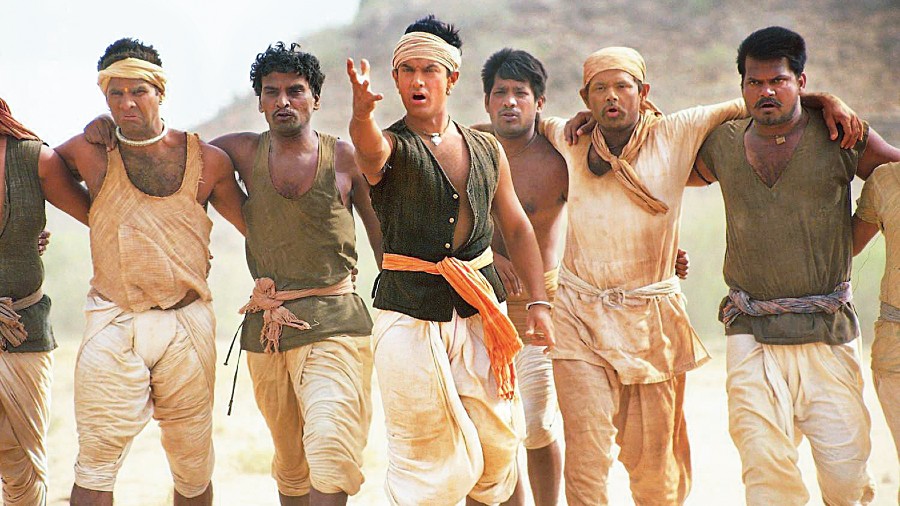This is just my theory but I am sure Lagaan — a great movie which is celebrating its 20th anniversary — would have won an Oscar if Aamir Khan, the film’s producer and male lead, and Ashutosh Gowariker, its director, had ensured that the hero, Bhuvan, goes off not with the village belle, Gauri (Gracy Singh), but with the English woman, Elizabeth Russell (Rachel Shelley). Russell is the one who tells Bhuvan of her feelings in painfully learnt Hindi, and she risks the wrath of her brother, Captain Andrew Russell — Paul Blackthorne — and the colonels of the raj by siding with the villagers and teaching them the rules of cricket.
In June 2001, I was privileged to attend Lagaan’s world premiere at the Warner Village Cinema in Leicester Square. In March 2002, I was in the lobby of the Wyndham Bel Age in Los Angeles as the stars of Lagaan departed for the Oscar ceremony. Alas, Lagaan lost to the Bosnian No Man’s Land for best foreign language film. In 2005, I went to Eton College where Andrew Robinson, a history teacher and cricket master, was using Lagaan to give his pupils a decidedly pro-Indian view of the raj (remember five governor-generals and 11 viceroys, including Curzon, were educated at Eton). In May 2011, I chanced upon Gowariker at the Cannes Film Festival and offered my reworking of Lagaan. He was taken aback for a second, then laughed: “That wouldn’t work in India!”
Maybe not, but the possibility of a radical departure had occurred to the late Roger Ebert, legendary film critic of the Chicago Sun-Times: “[T]here is the intriguing question of whether the hero will end up with his childhood sweetheart, or cross color lines with the Victorian woman...”
Dark past
Patna couldn’t be further away from idyllic England and yet when the Famous Five — Julian, Dick, Anne, Georgina and their dog, Timmy — landed on Kirrin Island, I joined them on this and other thrilling adventures. How I loved Enid Blyton’s The Famous Five and The Secret Seven stories. As a child I was not aware, however, of some of her racial stereotypes. English Heritage, which puts up blue plaques to mark where notable people such as Tagore, Gandhi and Nehru have lived in London, is updating its website to take note of Blyton’s questionable opinions.
Her plaque remains unaltered but her online biography now reads: “Blyton’s work has been criticised during her lifetime and after for its racism, xenophobia and lack of literary merit. A 1966 Guardian article noted the racism of The Little Black Doll (1966), in which the doll of the title, Sambo, is only accepted by his owner once his ‘ugly black face’ is washed ‘clean’ by rain... In 2016, Blyton was rejected by the Royal Mint for commemoration on a 50p coin because, the advisory committee minutes record, she was ‘a racist, sexist, homophobe and not a very well-regarded writer’. Others have argued that while these charges can’t be dismissed, her work still played a vital role in encouraging a generation of children to read.”
Celebrate diversity
From Columbia University, Vidya Dehejia, the Barbara Stoler Miller Professor of Indian and South Asian Art, tells me of two new books. One, published by Princeton University Press, is The Thief Who Stole My Heart: The Material Life of Sacred Bronzes from Chola India, 855-1280. She estimates that more than 1,000 temples were built over four centuries. “During the Chola period, maybe 10,000 bronzes would have been produced.” The other, brought out by Roli Books, is India: A Story Through 100 Objects. She will be discussing it today, with William Dalrymple, during the Khushwant Singh LitFest (London).
Dehejia, one of the world’s leading experts on Indian art who received the Padma Bhushan in 2012, explained: “India’s not just one thing — it’s a mixture of all sorts of things. The multiculturalism of India is my focus in this book. There’s a Koran page in it. There’s an Islamic gravestone and a Jahangir album in it. There’s a Zoroastrian bowl in it, there is the ketubah (a Jewish marriage contract) and, of course, there’s a lot of Hindu stuff in it. Our strength lies in the multicultural mix that we are instead of just talking about Hinduism and Hindutva. We have amalgamated so many streams and taken the best from all of them to become what we are and we should celebrate that.”
Power wins
The powerful pro-Winston Churchill lobby has registered a notable victory. Churchill College, Cambridge, which has been conducting a year-long programme to examine whether he was responsible for aggravating the effects of the 1943 Bengal famine, has been stopped in its tracks. The halt was announced by Dame Athene Donald, Master of the college, after heavy pressure from Churchill’s grandson, Sir Nicholas Soames, and right-wing newspapers.
Its prime mover, Prof Priyamvada Gopal, a Fellow of Churchill College, is furious. She claims that “under pressure from groups like Policy Exchange & some members of the Churchill family, Churchill College has disbanded a group set up to engage critically with Churchill’s complicated legacies”.
Footnote
This is an important moment for the British Indian community. Shannon Singh, 22 years old, the daughter of a Punjabi father and a Scottish mother and described as “a former glamour model, social media influencer and DJ”, is to the first Indian origin contestant on Love Island, a risqué reality TV show in which photogenic young men and women are isolated on an island and encouraged to endlessly couple and decouple and find “romance”.










